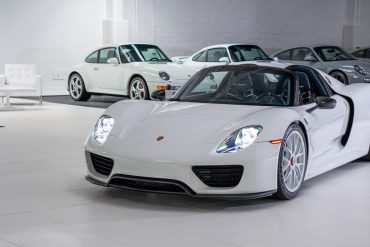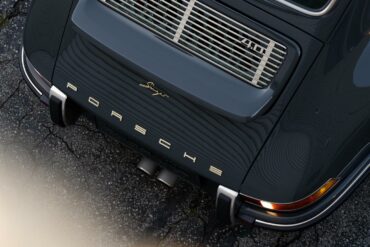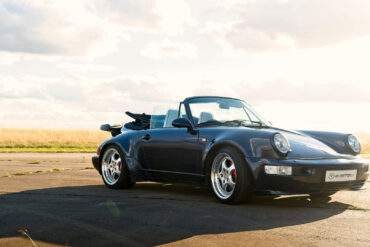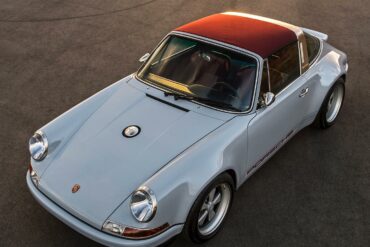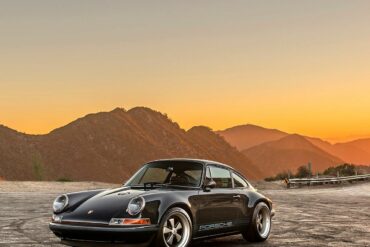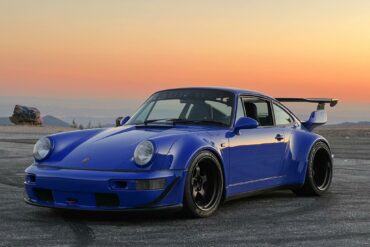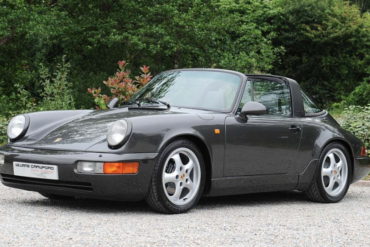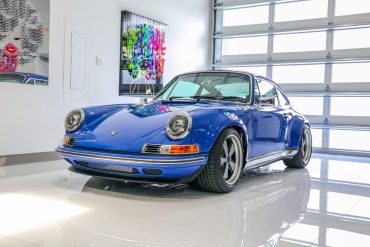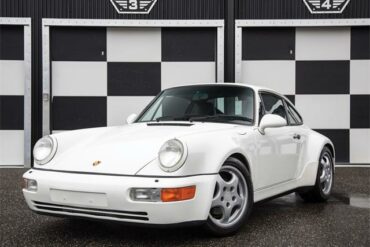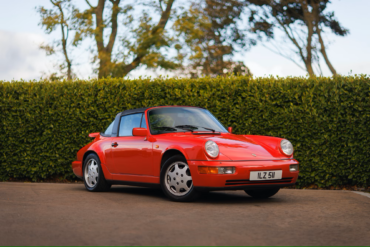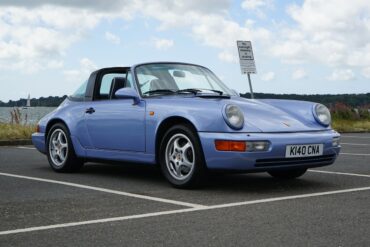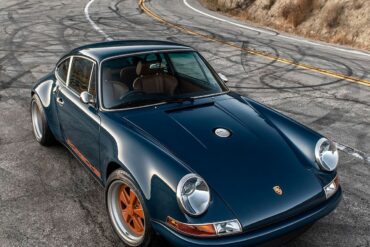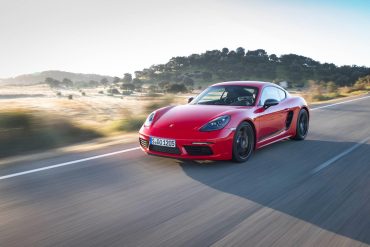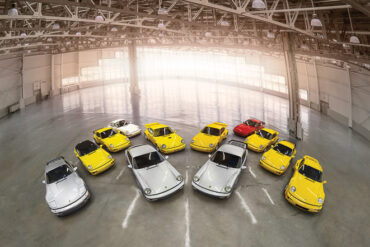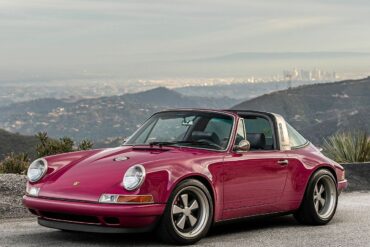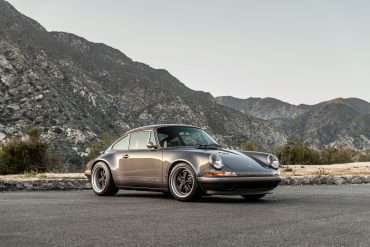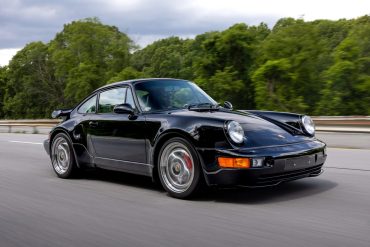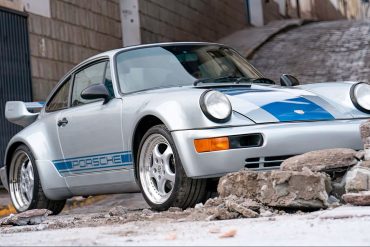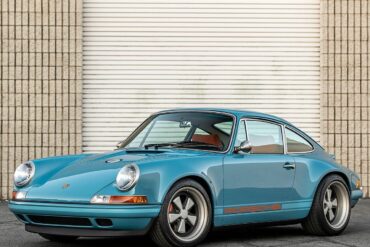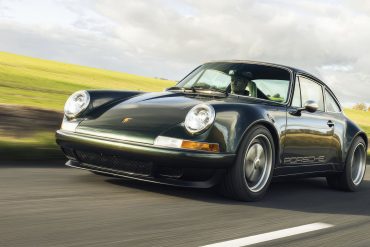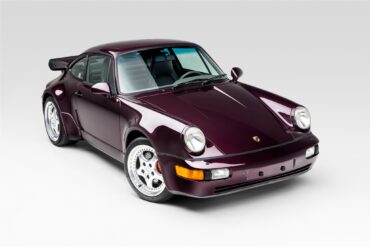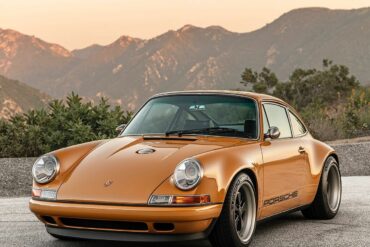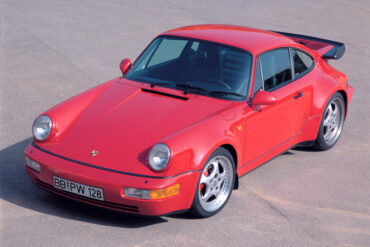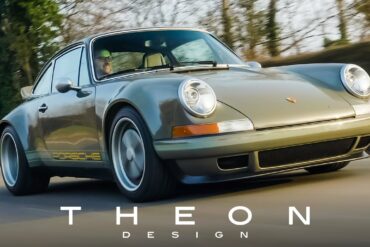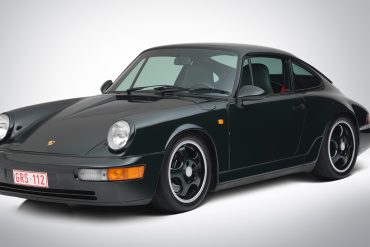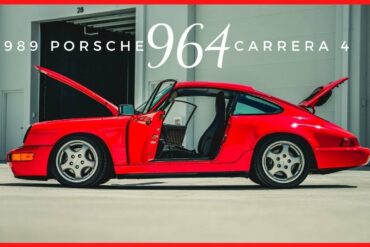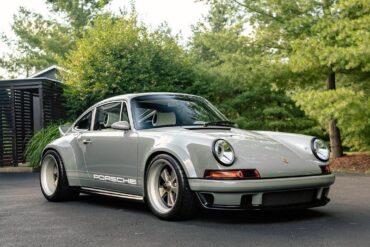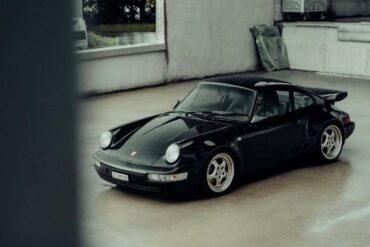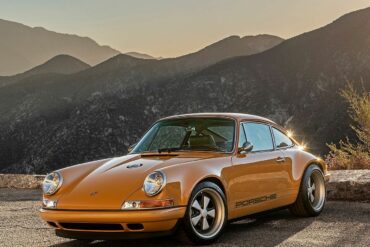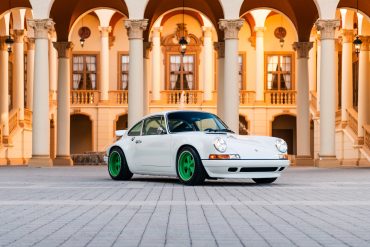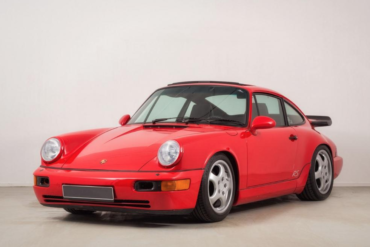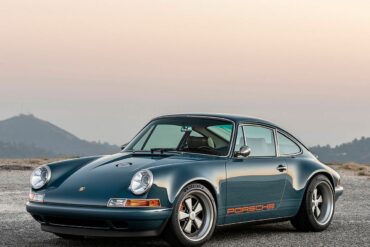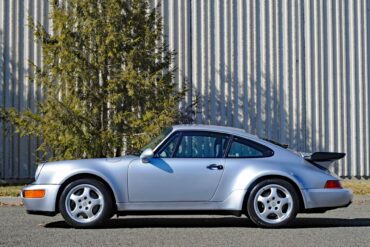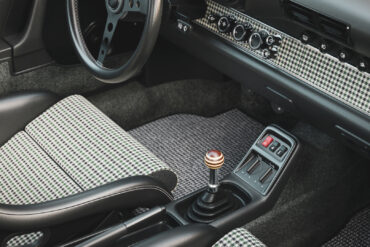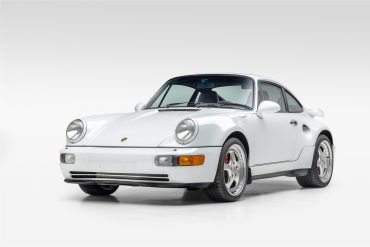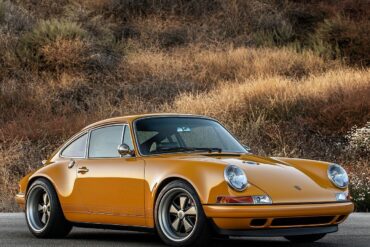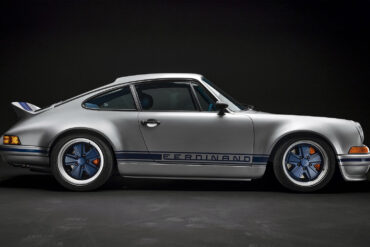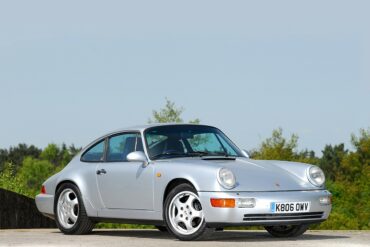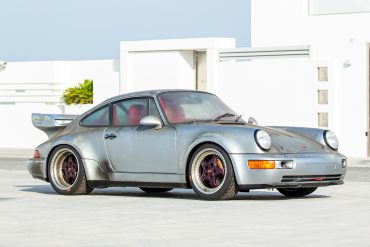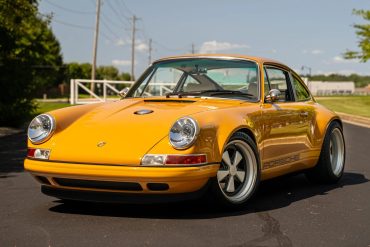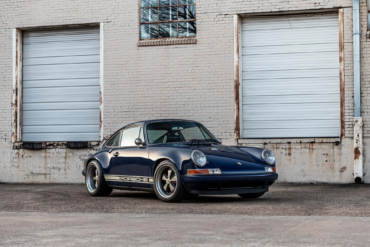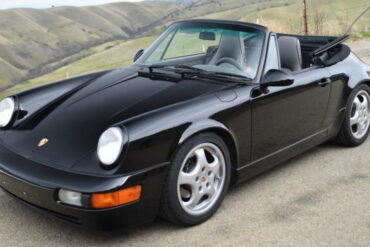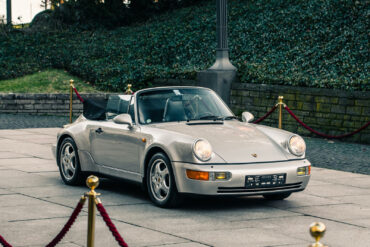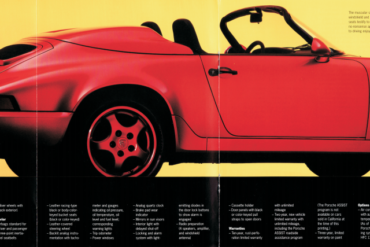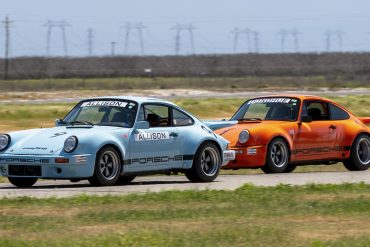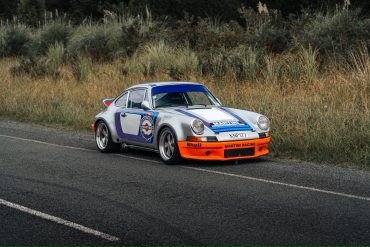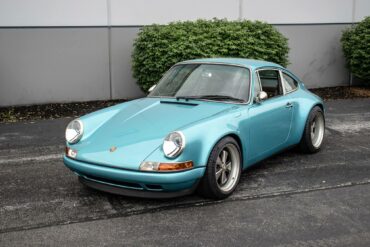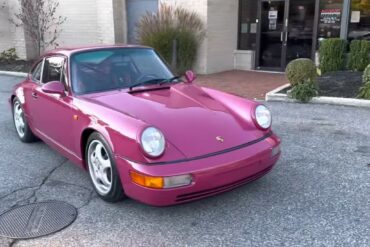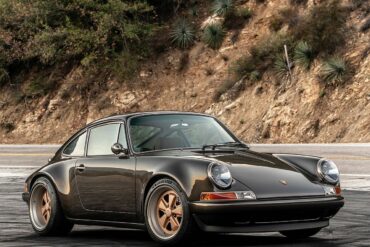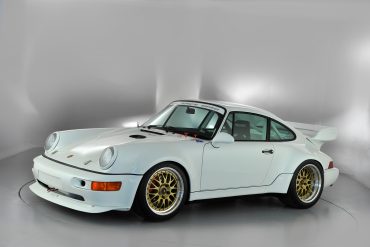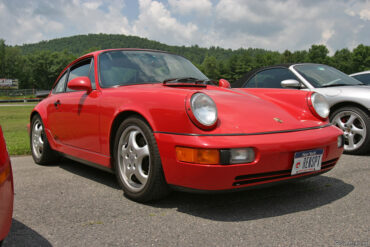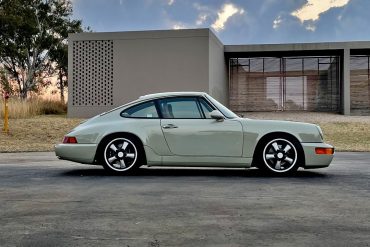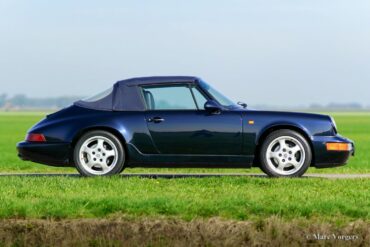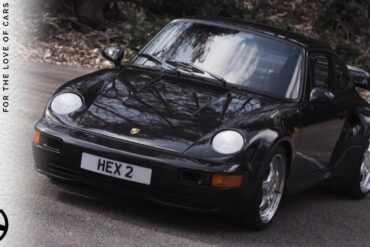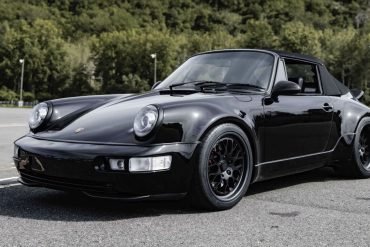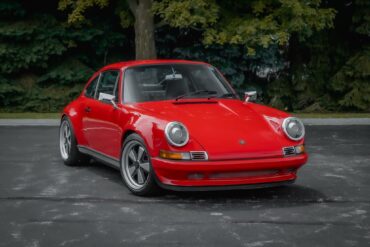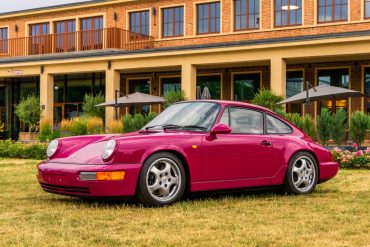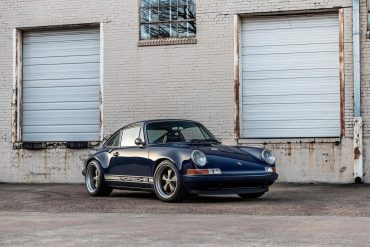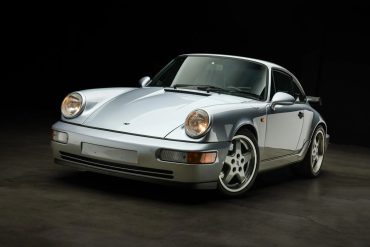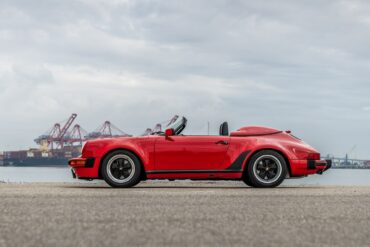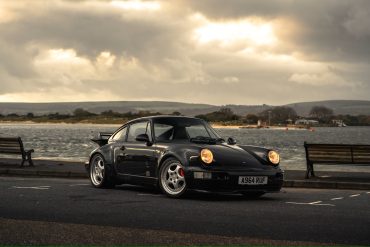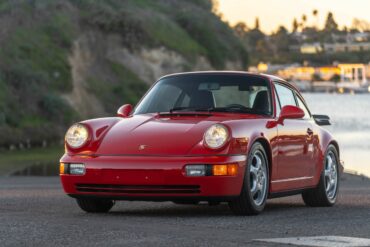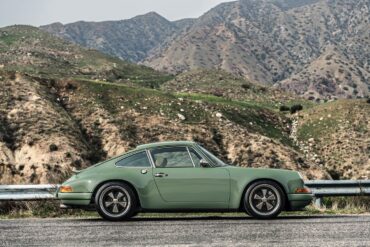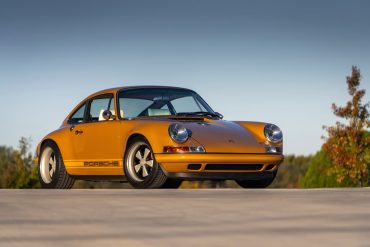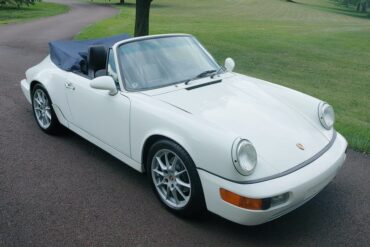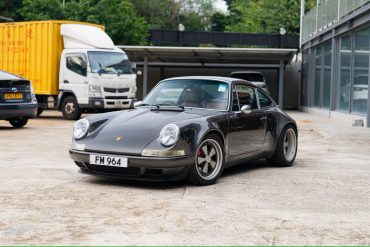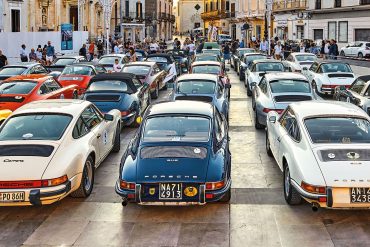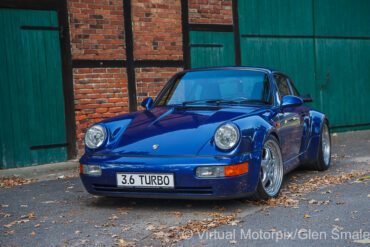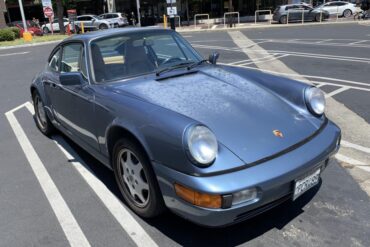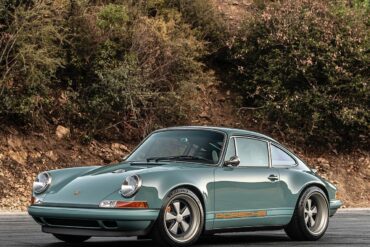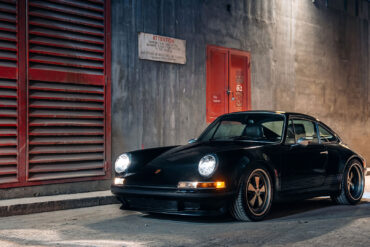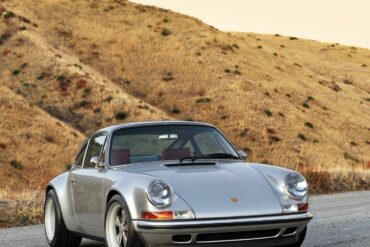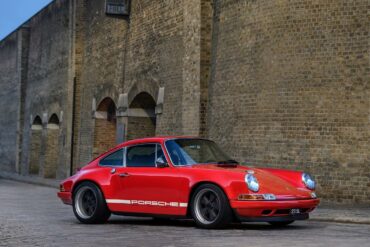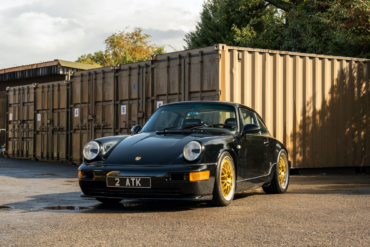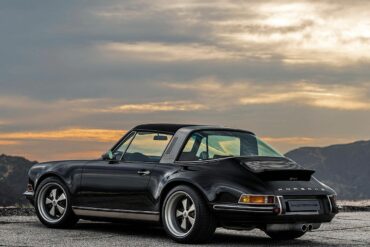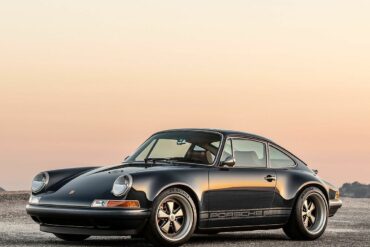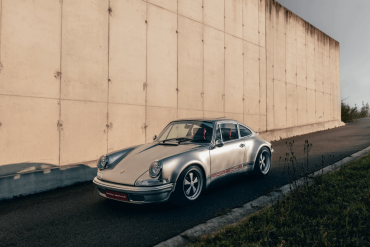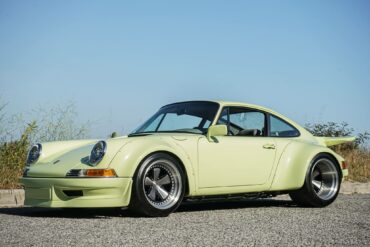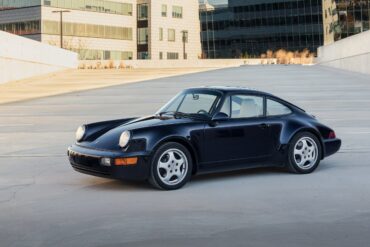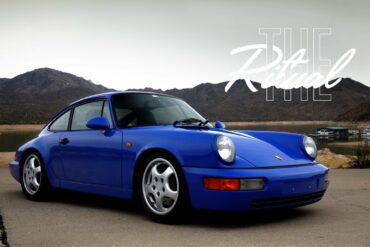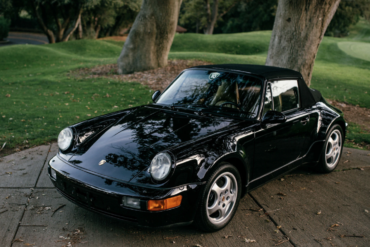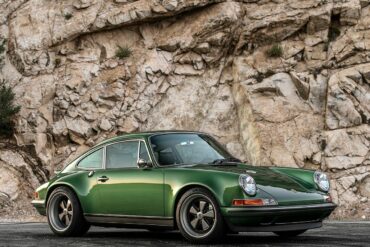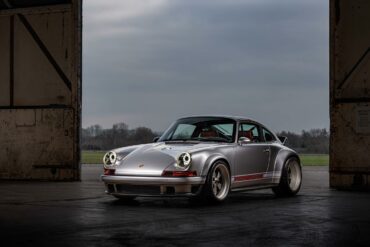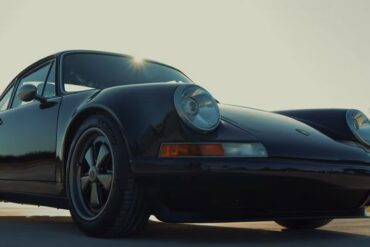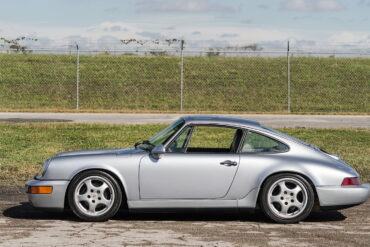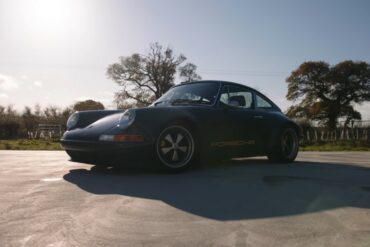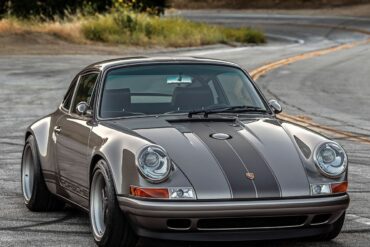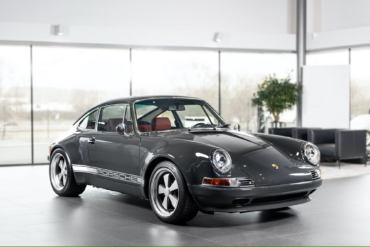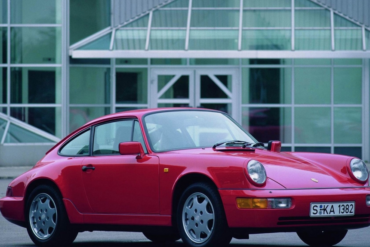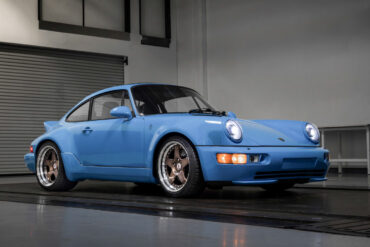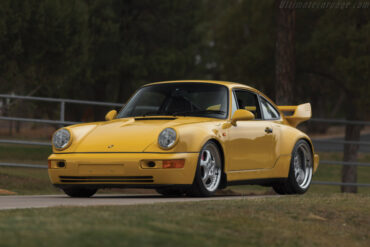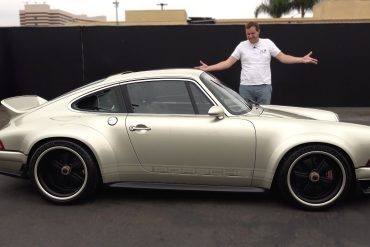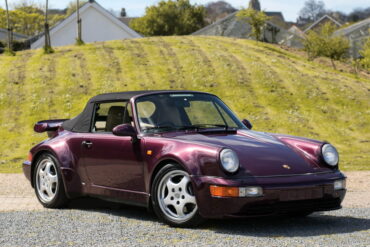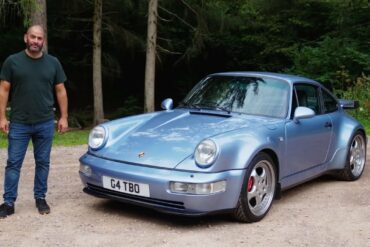You already read about our preview of The White Collection auction here on Stuttcars. Fifty-five Porsches, mostly in white, with...
Porsche 911 (964)
In 1989 Porsche came out with the 911 Carrera 4 (964). The new 911 was a contemporary take on the classic two-door sports car and came at a time when many were predicting the end of the 911 (the company was producing the 944 and working on the upcoming 968). The long run of the previous 911 meant the 964 needed a major update and Porsche delivered on that promise with 85% new components and virtually none of the predecessor’s architecture used. Save for the introduction of aerodynamic polyurethane bumpers and an automatically-extending rear spoiler which replaced the “whale tail” found on the 911 throughout the 1980’s, externally, the 964 kept the same style as the classic 911. The 964 rode on a completely redesigned chassis with rear suspension switching from torsion bar to trailing arms with Porsche’s “Weissach” rear axle, which added self-steering elements to reduce the chance of oversteer. It featured a naturally aspirated 3.6 liter boxer engine that produced an impressive 250 horsepower. See all of our Porsche 964 Research.
Singer Vehicle Design – Stockholm Commission Today, we take a closer look at the Singer Vehicle Designs Stockholm Commission. It...
Founded in Los Angeles in 2009, Singer is globally renowned for bespoke restorations of Porsche 911 sports cars. Based on...
Everrati Automotive Limited (Everrati), the leading global technology company specializing in redefining and futureproofing automotive icons, today reveals its electrified...
Singer Vehicle Design – Colorado Springs Commission Today, we take a closer look at the Singer Vehicle Designs Colorado Springs...
Singer Vehicle Design – Tatooine Commission Today, we take a closer look at the Singer Vehicle Designs Tatooine Commission. Like...
This one-of-a-kind RWB build boasts custom hand-fitted bodywork, including modified bumpers, rocker panels, bolt-on fenders, a GT2-style rear wing, a...
1991 Porsche 911 Carrera 4 Targa (964) Technical Specifications Engine Type Flat 6 Induction Normally-aspirated Cooling Air/oil-cooled Valvetrain Single overhead...
Starting with a European-market 964 Carrera 4 that retains its original numbers, this 1991 model underwent an extensive custom nut-and-bolt...
Model year 1994. Carrera 4 Wide-Body for the U.S. Technically there is really no difference between the Carrera 4 Wide-Body and his RoW counterpart. At the front there are the for America usual black impact absorbers beside the fog lights, the frontfenders lack the side indicators, the rear bumper is equipped with the center piece with a small plate section and in the back window of a large third brake light is integrated. Significant differences, it is generally provided in the factory standard equipment.
Collecting Cars is auctioning a stunning example of the 964-generation Porsche 911 Carrera 2 Targa. This particular example is offered...
1992 Porsche 911 Carrera 4 Targa (964) Technical Specifications Engine Type Flat 6 Induction Normally-aspirated Cooling Air/oil-cooled Valvetrain Single overhead...
Singer Vehicle Design – Silverstone Commission Today, we take a closer look at the Singer Vehicle Designs Silverstone Commission. The...
On a different budget? Check out our other Buyer’s Guides: Budget Based Porsche Buyer’s Guide: Up to $25,000 Budget Based...
RM Sotheby’s Amelia Island auction sale – Porsche 964 Collection Now in its 20th year, RM’s 2018 Amelia Island sale...
This is a modified 1990 Porsche 911 Carrera 2 Targa, known as the “Max Power” commission, which was worked on...
Dubbed the “Lautrec Commission,” this custom Porsche 911 reimagined by Singer showcases an extraordinary and meticulously planned specification. Similar to...
This 1994 Porsche 911 Turbo S 3.6 Package is a stunning example of one of the 17 “Package” models produced...
After debuting in its famed role in “Transformers: Rise of the Beasts”, the Autobot Mirage and the movie car, a...
Singer Vehicle Design – Southampton Commission Today, we take a closer look at the Singer Vehicle Designs Southampton Commission. The...
Theon Design has revealed its latest bespoke Porsche 911 (964), its second for a UK customer. Finished in classic Oak...
Singer Vehicle Design – Westlake Commission Today, we take a closer look at the Singer Vehicle Designs Westlake Commission. The...
This 1994 Porsche 911 belongs to a limited production run of around 1,500 Turbo 3.6 models manufactured during the 1993...
Singer Vehicle Design – Palm Beach Commission Today, we take a closer look at the Singer Vehicle Designs Palm Beach...
The Porsche 911 Type 964 RSR, designed for international GT racing by privateers, represents a significant evolution in the 911...
The 1989/90 change of model year saw the launch of the Porsche 911, 964 series onto the market. This 911 model was initially available as a Coupe, Targa and Convertible. From model year 1991 onwards Porsche also introduced its top-of-the-line model - the Turbo - into this series. In spite of bearing a major similarity in terms of look to the naturally-aspirated model, the extended wings remained. This meant that the new Porsche could retain its turbo look. The 964 Turbo model was the successor to the Porsche 930. The 964 Turbo was the end of an era, the last of the single turbo rear-wheel drive 911 Turbos.
Theon Design’s Take on the 911 Theon Design are behind a few amazing 964 Porsche 911 Restomods and Henry Catchpole was...
Porsche introduced the 964 Carrera RS for the 1992 model year, specifically targeting the European market as a lightweight, high-performance...
Test Driving a 1989 Porsche 964 Carrera 4 ...
Singer Vehicle Design – Quartz DLS Commission Today, we take a closer look at the Singer Vehicle Designs Quartz Commission....
The 1989/90 change of model year saw the launch of the Porsche 911, 964 series onto the market. This 911...
The Hollywood Commission is a special car and it represents an important link between the origins of Singer and the...
Established in Los Angeles in 2009, Singer Vehicle Design is a prominent figure in reimagining Porsche 911s from the 964-generation...
Porsche 911 Spare Parts Catalogs (964, 1989 – 1994 Model Year) These official Porsche PET Diagrams and codes for the...
Singer Vehicle Design – Michigan Commission Today, we take a closer look at the Singer Vehicle Designs Michigan Commission. This...
Porsche Option Codes – Porsche 911 (1992 Model Year) Looking to decode your 1992 Porsche 911 option codes? Want to...
Porsche 911 (964) Transmission Codes The transmission number code is found on the transmission data plate. There were two codes...
The 964 generation has become highly popular, primarily due to its iconic styling and air-cooled design. Among the 964 models,...
Singer Vehicle Design – Raffles Commission Today, we take a closer look at the Singer Vehicle Designs Raffles Commission. The...
Air-Cooled 911 “Brawler” Of all the cars on the market, the Porsche 911 is arguably the one that’s seen the...
1993 Porsche 911 Carrera 4 Coupe (964) Technical Specifications Engine Type Flat 6 Induction Normally-aspirated Cooling Air/oil-cooled Valvetrain Single overhead...
Bonhams will auction one of the two existing examples of the Porsche 911 Carrera RSR 3.8-liter “Strassenversion” Coupé on November...
Singer is widely recognized as a top name in the world of Porsche 911 tuning and restoration. Each Porsche 911...
Singer Vehicle Design was founded in 2009 with the purpose of preserving the legendary air-cooled Porsche 911. The level of...
1994 Porsche 911 Carrera 2 Cabriolet (964) Technical Specifications Engine Type Flat 6 Induction Normally-aspirated Cooling Air/oil-cooled Valvetrain Single overhead...
Porsche 911 Type 964 Carrera 2 'Works Turbo Look' Cabriolet was a special model in the 964 lineup. It gave buyers of the Carrera 2 Cab the great wide look of the Turbo cars and the Carrera 2 engine. The model was available as a 1992 and 1993 model year car (while some argue it was also available for a while in 1994). You get body shape of the 964 Turbo 3.3 without the huge rear spoiler. But this was more than just a design exercise, because the the Turbo-Look models also got the chassis and braking system from the Turbo 3.3 too.
Porsche 911 Sales Brochures (Type 964) We didn’t do well in trying to score some Porsche sales brochures for the...
The 15th Targa California rally recently concluded with most drivers logging 1,000+ miles over the roads “less traveled” of California’s...
This 964-generation Porsche 911 Carrera 2 has been elegantly transformed into a tribute to the iconic RSR model. Externally, it...
The Sundown Commission is a stunning example of Singer’s craftsmanship and attention to detail. It features a beautiful Horizon Blue...
Autosport Designs takes the Porsche 911/964 RS N/GT Clubsport for a test drive. One of only 290 examples produced and...
Singer Vehicle Design – Indy Commission Today, we take a closer look at the Singer Vehicle Designs Indy Commission, a...
Every so often, Porsche creates a short production run of cars that celebrates the attributes of one of their special...
The original 1973 Carrera RS was available in Europe but not in the USA. Porsche decided to build the 1993 Carrera RS both to European spec and a limited number in compliance with US regulations. These US spec cars were assigned the name “RS America”. The intent was to create a basic lightweight, no frills 911 with minimal luxury options. The standard US Carrera 2 brakes, engine and gearbox were used. The RS weighed 2,945 pounds so it was almost 80 pounds lighter than a standard Carrera 2.
On-board drive & in-depth review An on-board drive & in-depth review of the specs and build principles applied to our...
1992 Porsche 911 Carrera 2 Cabriolet (964) Technical Specifications Engine Type Flat 6 Induction Normally-aspirated Cooling Air/oil-cooled Valvetrain Single overhead...
Ultra Rare, Ultra Cool Have you ever seen a 911 Flatnose before? Neither had we. Here’s the story of one...
While I admit the title is misleading, American company Sacrilege Motors does have the answer to the question; “Both.” That’s...
The 1990 Porsche 911 Carrera 4 underwent a comprehensive restoration and backdate by Abreu Motors. It features a Guards Red...
In the early 1990s, Porsche focused on showcasing its new 964 Carreras globally in racing. The company developed track-ready versions...
Singer Vehicle Design, founded in 2009 by former Catherine Wheel frontman Rob Dickinson and based in Los Angeles, specializes in...
A rare gem has surfaced on Bring A Trailer – a 1994 RUF RCT, possibly the only one ever built...
The 1989 model of Porsche’s 911 Speedster model lineup is arguably one of the most recognizable as the 911 Speedster...
In 1993, the 964 Turbo introduced an entirely new engine configuration to critical acclaim. The engine’s displacement was increased to...
Sackey & Co. is proud to offer a stunning example of a 1993 Porsche 911 RS America finished in factory...
Singer Vehicle Design – Linden Green Commission Today, we take a closer look at the Singer Vehicle Designs Linden Green. Linden...
The “Indy Commission” by Singer Vehicle Design was built for IndyCar legend Dario Franchitti. Powering the Indy commission is a...
This Saturday, Mecum Auctions will be offering a beautiful 1990 Porsche 911 Carrera 2 Coupe that has been reimagined by...
1991 Porsche 911 Carrera 2 Cabriolet (964) Technical Specifications Engine Type Flat 6 Induction Normally-aspirated Cooling Air/oil-cooled Valvetrain Single overhead...
Theon Design is rapidly establishing itself as a prominent figure in the realm of 911 restomods, specializing in the 964-generation...
“To hell with the timing. This is more important,” Wilfried Reinhardt says to himself. He hesitates for just a moment,...
Engine based on modified 3.6 litre 964 unit. Speedline wheels with big red brake calipers. Lessons learned in the Carrera Cup series proved the reliability of the new 3.6-litre engine. An additional three millimetres on the bore and two millimetres on the stroke, resulted in an increase in capacity of 300 cc. Combined with the turbo optimised cylinders, pistons and crank train, and an increase in the compression ratio from 7.0 to 7.5:1, this helped to boost power to 360 bhp. Torque was increased significantly to 520 Nm at 4200 rpm, up from 450 Nm at 4500 rpm in the earlier car.
The Type 964 911 first launch with an all wheel drive model. It was a serious investment by Porsche in updating the chassis and tech platform. The 964 Carrera 4 was powered by the M64/01 3.6 liter flat six engine, developing 250 bhp and 229 ft/lbs of torque. The objective of the C4’s all-wheel-drive system was not only to provide improved traction but also better handling, especially in the wet and on slippery surfaces. The system sends power front/back in a 31:69 ratio because a 50:50 split would have made the 964 feel like a front-wheel-drive car.
Singer Vehicle Design – Long Island Commission Today, we take a closer look at the Singer Vehicle Designs Long Island...
The latest bespoke Porsche 911 (964) commission to come out of Theon Design’s Oxfordshire workshops has been unveiled – the...
Singer Vehicle Design – Mexico Commission Today, we take a closer look at the Singer Vehicle Designs Mexico Commission. At...
Singer Vehicle Design – Le Mans Commission Today, we take a closer look at the Singer Vehicle Designs Le Mans...
Porsche decided to build the 1993 Carrera RS both to European spec and a limited number in compliance with US...
Singer Vehicle Design – Easthampton Commission Today, we take a closer look at the Singer Vehicle Designs Easthampton Commission. At the...
Singer Vehicle Design – Newport Commission Today, we take a closer look at the Singer Vehicle Designs Newport Commission. This...
The Madster RT is a remarkable European-market 1991 Porsche 964 Carrera 2 that underwent a complete restoration and customization by...
Since it was founded in 2009, Singer has carved a global niche for meticulously personalizing Porsche 911s. Working with each...
This 1991 Porsche 964 Carrera 4 is an exceptional, one-of-a-kind build that was commissioned to RWBLA, a team of experts...
1994 Porsche 911 Carrera 4 Coupe (964) Technical Specifications Engine Type Flat 6 Induction Normally-aspirated Cooling Air/oil-cooled Valvetrain Single overhead...
Rituals of Rennsport The power of Porsche is rarely measured on a dyno, but you can always tell when it’s...
The American Roadster is essentially a turbo-bodied Carrera Cabriolet with Turbo suspension and brakes. Like the 356 America Roadster it was named after, the Type 964 America Roadster was a limited-edition, driver-focused convertible destined for the American market. Production for the America Roadster was limited at only 250 examples, and the model was only produced in 1992 and 1993. Its engine was a standard unit making 250 horsepower, but the special edition had the wide fender flares, suspension, brakes, and 17-inch Porsche Cup wheels of the 911 Turbo.
Singer Vehicle Design – Copenhagen Commission Today, we take a closer look at the Singer Vehicle Designs Copenhagen Commission. This...
Singer Vehicle Design – Racer X Today, we take a closer look at the Singer Vehicle Designs “Racer X”. This...
UK-based Theon Design firm is a small shop that is currently in the spotlight for their partially carbon fiber-bodied Porsche...
Porsche Option Codes – Porsche 911 (1993 Model Year) Looking to decode your 1993 Porsche 911 option codes? Want to...
Alex Kersten goes behind the wheel of the 1 of 1 Theon BEL001, a restomod Porsche 911 (964) for a...
Singer Vehicle Design – Fredericksburg Commission Today, we take a closer look at the Singer Vehicle Designs Fredericksburg Commission. The...
This ‘Sooner’ 911 is based on a 1990 964 Carrera 2 and has undergone significant modifications to both its appearance...
Porsche added the rear wheel drive Carrera 2 variant to the range in 1990. It was developed alongside the 964 Carrera 4, Porsche waited a year to release the Carrera 2 as a 1990 model year car. Like the Carrera 4, the Carrera 2 was available as a coupé, Targa or Cabriolet. Overall, the Carrera 2 packed almost the same technical specifications as the Carrera 4 model. The engine was the same 3.6 liter unit which produced 250 horsepower and a maximum speed of 162 mph. Looked like C4 but was 200 lb lighter and more fun to drive.
Everrati Automotive Limited (Everrati™) has completed the build of its first Porsche 911 (964) for the U.S. market. Featuring a state-of-the-art...
Strap in as Christian Gebhardt from sport auto pushes a Porsche 911 (964) Carrera RS to its limits around the...
The 964 Carrera RS 3.8 was produced as a base for homologation for the venerable 3.8 RSR. It was unveiled in 1993 and produced in a very small series by Porsche’s Racing Department in Weissach-Flacht, and was an extreme evolution of the 964 Carrera RS that was released two years prior. It featured the wide-body look of the Type 964 Turbo, a massive rear spoiler, and three-piece “Speedline for Porsche” wheels with 235/40 and 285/35 tires, making it distinctively more aggressive in appearance than the fairly restrained styling of the Carrera RS of 1992 and capable of providing significantly more mechanical grip.
Touted by Singer as the ‘most advanced air-cooled 911 in the world’, the Singer DLS has a custom-bored 4.0L flat-six...
The Turbo-look Porsche 964 has always been a very desirable automobile, among them 1,532 Carrera 2 Cabriolets constructed worldwide. Within that group, there were some cars that were even more specialized. The Register says six Turbo-look cabriolets were pulled off the production line in Zuffenhausen and transported to the Porsche Exclusive shop in Weissach. Three of these six powerful and luxuriously equipped drop-tops were equipped with left-hand drive for buyers in Germany (Code C00), and the other three were fitted with right-hand drive
Jenson Button’s Porsche 964 Turbo 3.6 For Sale The Porsche 911 Turbo 3.6 is a rare modern classic supercar, and...


